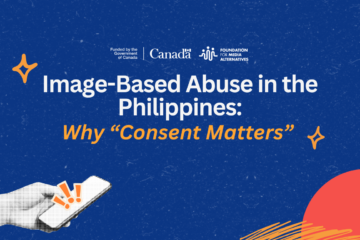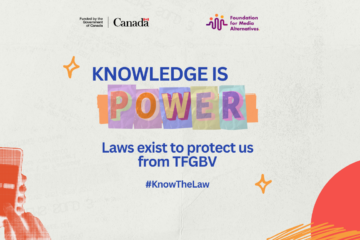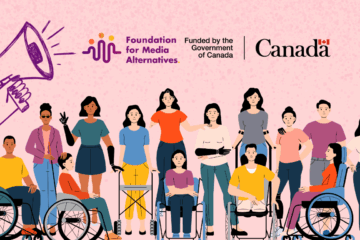Online Gender-Based Violence in the Philippines: 2023 Midyear Report

As technology continues to define the landscape of our everyday lives, it may also be used as an instrument to bring forth new forms of gender-based violence (GBV) and exacerbate existing inequalities experienced by and disproportionately affect women and girls.
Technology-facilitated GBV is any act that is committed, assisted, aggravated or amplified by the use of information communication technologies or other digital tools (UN Women, 2023). These forms of violence are often overlooked because of the perception that no direct bodily harm is inflicted upon victim-survivors. However, acts of violence, whether facilitated through technology or otherwise, result in physical, sexual, psychological, economic, social, and political harms as well as other infringements of rights and freedoms (UNFPA, 2023)
The Foundation for Media Alternatives (FMA) initiated an effort to map online gender-based violence (OGBV) cases in the Philippines in 2012; and as of June 2023, the organization has mapped 686 cases sourced from media reports, online correspondences from individuals, and personal narratives of victim-survivors from different communities across the country.
Mapped OGBV cases from January to June 2023
From January to June 2023, FMA mapped 27 OGBV cases, a 15 percent decline from the 33 cases logged within the same time period last year. The statistic may consist of multiple offenses. The most common forms and manifestations of OGBV are non-consensual production and/or dissemination of intimate images or videos (81%), threats of violence and/or blackmail (44%), and physical and/or sexual abuse (19%). Other offenses include spying, surveillance, or device-facilitated violence (11%); harassment or abusive speech (7%); control and manipulation of accounts and information (4%); and trafficking (4%).
The locations with the most OGBV cases are the National Capital Region (15 cases); Central Luzon (4 cases); and CALABARZON (2 cases). Other regions with one mapped case each are Western Visayas, Eastern Visayas, Central Visayas, Northern Mindanao, and Davao Region.
The victim-survivors in the mapped cases are all women and girls with 40% being below 18 years old [undisclosed legal age (36%), 18 to 30 years old (14%), 30 to 45 years old (7%), and 45 to 60 years old (3%)]. The perpetrators in the mapped cases are all men or boys with 76% having known relations with the victim-survivors. They may be current or ex-partners, family members, friends, or acquaintances.
The invisible prevalence of online sexual violence
In the Philippines, 1 in 20 women and girls aged 15 to 49 have experienced sexual violence in their lifetime (NDHS, 2017). This does not paint a complete picture as GBV cases often go unreported because of victim-survivors’ fear of social sanctions; the normalization of violence within households; and the weak mechanisms in accessing justice, among many other factors.
Official data on sexual violence facilitated through technology is even more challenging to track down given the lack of readily available information. However, FMA has found that all 27 mapped OGBV cases from January to June 2023 are varying forms of sexual violence and that there may be a need to sound the alarm on the staggering prevalence of online sexual abuse and harassment These cases include threats to expose intimate images and videos, lewd messages, voyeurism, sexual assault, cyber pornography of minors, and trafficking for sexual exploitation.
Non-consensual production and/or dissemination of intimate images or videos is the most common form of OGBV among the mapped cases. Of these, half are cases of intimate partner abuse wherein the perpetrators (all men) are current or former partners of the victim-survivors (all women). In many cases, these images or videos were initially taken with the consent of the victim-survivors, trusting that their partners would handle it confidentially. However, upon the dissolution of these relationships, the perpetrators used these materials as leverage for blackmail or threats of violence. In these cases of sexual extortion, the perpetrators (all men) threatened the victim-survivors (all women) to expose their intimate images or videos in exchange for money, sex, or continued romantic relations.
In San Isidro, Nueva Ecija, a 55-year-old widow reported that she was being extorted for 3,000 pesos by a man who claimed to be her former partner and threatened to disseminate her intimate images and videos. The now-nabbed perpetrator revealed that he had no relations with the victim-survivor and only found the images and videos on a pornography site that included personal information of the victim-survivor. The victim-survivor inferred that her images, videos, and personal information were posted online by a former partner who is non-Filipino and is based overseas.
In Caloocan City, a woman of legal age reported that her former partner, a 31-year-old man who was disgruntled after the victim-survivor ended their relationship ahead of their two-year anniversary, shared her intimate images to their friends and threatened that the images would only be deleted if she agreed to meet up with her ex-partner.
In Angeles City, Pampanga, there is a similar case wherein the offender threatened to publish his former partner’s intimate videos in exchange for sex.
Gender justice for victim-survivors of OGBV
Despite having forwarded these mapped cases to the authorities for investigation, perpetrators of OGBV are rarely held accountable (Broadband Commission, 2015) and countless more cases go unreported or are not pursued in part because of the lack of gender-transformative referral pathways for victim-survivors. This can be seen in the many incidents that were pursued via entrapment operations requiring victim-survivors to continue communications with their abusers until they are caught, ultimately putting women and girls at greater risk of violence or trauma.
Looking at the stories of women from Nueva Ecija, Caloocan City, and Angeles City, their cases strongly dispell the popular notion of technology-facilitated sexual violence having little to none impact to women’s lives. Similar to the GBV happening offline, OGBV exploits the existing gender inequality to further marginalize women and girls. With the perpetrators being predominantly men and boys and the victim-survivors all being women and girls, this effort to map out OGBV cases in the Philippines reiterates the call to view online violence and power inequalities from a gendered lens and to enact policies and programs with the objective of achieving gender justice.



0 Comments